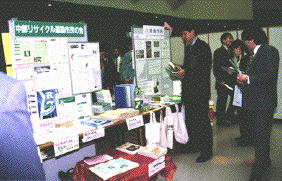 Science & Technology || Search || Back Numbers EARTH-FRIENDLY SHOPPING: "Green" Consumerism Catches On in Japan May 2, 1997
A number of organizations in Japan these days are trying to be more environmentally aware when purchasing products. The "buy green" movement has spread to nearly 700 companies, local governments, and private-sector organizations. Guidelines for assessing the environmental soundness of products are also being formulated. These guidelines not only will assist consumers in their purchasing decisions, but also, as environmental consumerism continues to spread, are likely to encourage manufacturers to develop more "green" products.
Guidelines for Buying Green
To promote its objectives, the GPN has gathered the information needed to make informed green purchases, has made that information available to the public, and has carried out public-relations campaigns. The organization has also devised some basic guidelines for green purchasing. First, we should choose products whose life cycle (from obtaining raw materials through disposal) exerts as little impact as possible on the environment. Second, we should purchase products from companies that show a strong concern for the environment. And third, we should become well-informed about the products and their manufacturers' and sellers' environment-related policies, and base our purchase decisions on that information. The member organizations of the GPN give a variety of reasons for their joining the network. According to one group, "we saw that the global environment was going downhill before our eyes. We decided it was important to look for things we could do right away, and since green purchasing was one of them, we joined the GPN." Another member group states that "before joining the network, even if we wanted to choose environmentally friendly goods, there just wasn't enough product information out there to help us make our choices." In response to these voices, the GPN is now in the process of formulating green purchase guidelines for specific types of products. One example is copy machines and printers. To be considered environmentally sound under the guidelines, these machines need to have energy-saving features, allow copying or printing on both sides of the paper, and make use of recyclable materials. Similarly, office paper needs to include a large proportion of recycled material and have a low bleach content. The Network plans to create similar guidelines for other products, including stationery and office supplies, home appliances, cars, and furniture.
Getting Consumers into the Act
But in order to be really effective, green purchasing needs to catch on among consumers too. To extend the movement beyond businesses and local governments to the general public, the Green Purchasing Network plans to host a symposium and several exhibitions during June, designated as Environmental Month. Other countries, most notably Germany, have employed green purchasing practices for a long time now. And since the latter half of the 1980s, green consumerism has become widespread in other parts of Europe and in the United States as well. In the United States, executive orders have been issued for the procurement of environmentally sound products, and these orders are now being carried out. The U.S. government has produced a guide to about 3,000 green products. Through the efforts of the GPN, Japan, too, is increasingly aligning its efforts with those in other nations around the world.
 Edited by Japan Echo Inc. based on domestic Japanese news sources. Articles presented here are offered for reference purposes and do not necessarily represent the policy or views of the Japanese Government.
Edited by Japan Echo Inc. based on domestic Japanese news sources. Articles presented here are offered for reference purposes and do not necessarily represent the policy or views of the Japanese Government.
|

